 |
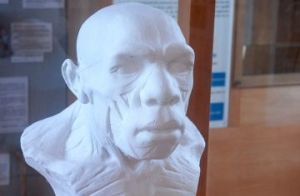
|
 Musée de l'Homme de Neandertal © T.Joly Musée de l'Homme de Neandertal © T.Joly

|
In a tiny village in Limousin, a museum tells you everything about Neanderthal man and introduces you to prehistoric life. Nearby, a cave inhabited by thousands of bats and boasting beautiful rock formations is also worth a visit.
[ Practical ]
Getting there
- By road
485 km from Paris to Brive-la-Gaillarde by autoroutes A6b, A10, A71 and A20.
Noailles is 9 km from Brive.
La Chapelle-aux-Saints is 31 km from Brive
- By train
Intercités from Paris Austerlitz to Brive-la-Gaillarde. The journey takes 4 h hours 30 mn.
- By plane
Air France flights from Paris Orly to Brive-la-Gaillarde.
Getting around
It’s necessary to have a car.
Lodging (in Turenne)
- Hotel
La Maison des Chanoines
- Bed and Breakfast
Le Clos Marnis
La Rocaille
Restaurants (in Turenne)
Le Vieux Séchoir
La Vicomté
La Maison des Chanoines
Musée de l’Homme de Neandertal
- Opening dates and hours
Open every day except Thursday from 2.30pm to 6pm from April 1st to June 30th and from September 1st to October 31st, every day from 10am to noon and from 2.30pm to 6pm in July and August.
Booking required in 2020.
- Admission
€5.50 / €3.50
- 2020 Prehistoric Festival
August 1st and 2nd.
- Information
Tel : 0555911800
www.neandertal-musee.org
Gouffre de la Fage
- Opening dates and hours
Open every day from 9.30am to 1pm and from 2pm to 7pm in July and August, every day except Wednesday from 2pm to 6pm from April 1st to June 30th and in September, Tuesday and Thursday at 3pm during All Saints school holidays.
- Admission
€8.50 / €5,50
- Information
Tel : 0555858035
www.gouffre-de-la-fage.com
Information
- Brive tourist office
Tel : 055240880
www.brive-tourisme.com
Nowadays, travellers accidentally passing through La Chapelle aux Saints are far from thinking that this peaceful tiny village of 200 inhabitants has marked the history of Prehistoric studies. Yet, it’s there, in the South of Corrèze, near Brive, that the Bouyssonie brothers unearthed the first complete skeleton of Neanderthal man on August 3rd 1908.
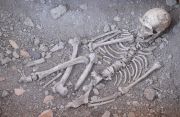
 Musée de l'Homme de Neandertal © T.Joly Musée de l'Homme de Neandertal © T.Joly
|
 40 000 years old man 40 000 years old man
At the time, the discovery caused a great sensation, especially since the position of the animal bones and stone tools found around the body also proved for the first time that prehistoric men living 40 000 years ago buried their dead and practiced funeral rituals. Since 1996 the village boasts a little museum dedicated to this Neanderthal man sometimes nicknamed the senior citizen of La Chapelle aux Saints because scientists established that he died in his 40s, a very venerable age in Prehistoric era. Of course, it doesn’t house the original skeleton – preciously kept in the Musée de l’Homme in Paris – but it provides a lot of fascinating information.
First, a room reminds of the circumstances of the discovery and the timeline of human evolution.
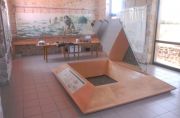
 Musée de l'Homme de Neandertal © T.Joly Musée de l'Homme de Neandertal © T.Joly
|
 Replica of the grave Replica of the grave
Then, the main room contains an exact replica of the skeleton and of the grave as well as a reconstitution of the Neanderthal man visage based upon the latest studies conducted during the 80s and 90s. It also hosts a comparison between skeletons of Neanderthal and modern men, explanations about the fauna and the climate of those times, a small collection of stone tools found in the cave and details about the wild game he hunted. In addition, a 18 mn long film features top pre-historians giving their point of view about the discovery and its consequences. Lastly, another room hosts temporary exhibitions always related to prehistory and human evolution.
If you plan to visit this museum with your kids, go there preferably on Wednesday, Saturday, Sunday and Bank holidays. On those days you can indeed participate in family workshops teaching how to make fire, how to shoot with an atlatl (spear thrower) and how to paint on cave’s walls.

 Bouffia Bonneval © T.Joly Bouffia Bonneval © T.Joly
|
 Flint cutting Flint cutting
And if you are a prehistory enthusiast, don’t miss the closest weekend of August 3rd. Each year on that date, the village commemorates the discovery of the skeleton with a Prehistoric Festival featuring the European prehistoric arch and atlatl Championship, a prehistoric feast, activities for young and old alike to learn cave painting, flint cutting, prehistoric camp building, jewels making as well as a book fair gathering together authors of comics, fiction novels and scientific works. Along with the Journées du Patrimoine, it’s also the only time of year where it’s possible to visit the cave where the discovery took place, the bouffia Bonneval. Located 1 km away from the village, it overlooks a river valley where herds of bisons, reindeers and horses once grazed. So this dwelling was also a good hunting spot. Having said that, the partly collapsed cave is hardly spectacular and the word bouffia - whose meaning is fox hole in local dialect - gives you an accurate idea of what it looks like.
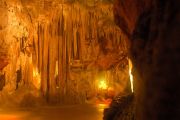
 Gouffre de la Fage © T.Joly Gouffre de la Fage © T.Joly
|
 Bones of prehistoric animals Bones of prehistoric animals
About thirty km from there, near Noailles, the pit of la Fage was also a mine of information for pre-historians who found there bones from 184 animal species that lived in the region between 300 000 and 400 000 years ago : mammoth, cave bear, giant lion, reindeer, megaceros, woolly rhinoceros,.. A few of these bones are on display, but the main attraction of this cave and the reason many tourists come is the beauty of its two galleries stretching for several hundred meters at depths ranging from 25 to 80 m. 450 m long, the first one is for most of the time a narrow corridor up to 20 m in height where are found stalactites, stalagmites and superb rocky concretions forming petrified waterfall, draperies, organ pipes, cauliflowers and columns. It ends in a room where these rocks sculpted by Nature are periodically enhanced by light effects. Shorter, only 250 m, the second one goes through a vast room where dozens of columns seem to support a ceiling adorned with thousands of stalactites.
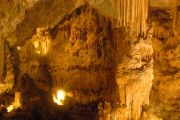
 Gouffre de la Fage © T.Joly Gouffre de la Fage © T.Joly
|
 Fourteen species of bats Fourteen species of bats
By carefully looking at the ceiling of the two galleries, it’s also possible to see bats sleeping or flying. Among the 33 species living in France, no less than 14 hibernate in la Fage including some of the rarest and four breed there. So, in order to not disturb them the pit is closed from November 1st to April 1st. Another exceptional feature is the number of individuals that varies according to the season, reaching up to 14 000 in winter and about 4 000 the rest of the year. Last but not least, in summer, at dusk they all get out of the pit within few minutes to fetch food offering an astonishing and striking aerial ballet. During the day, a 50mn long film gives information about the life and habits of these animals.
Ideally situated between La Fage and La Chapelle-aux-Saints, Turenne is the perfect place to stay if you plan to spend the night in the region. This picturesque village indeed boasts several lodgings and fine restaurants as well as many old buildings and a well-preserved medieval fortress.
May 30, 2020
Thierry Joly 

|



